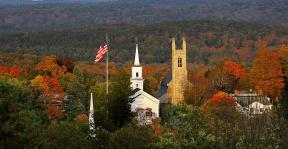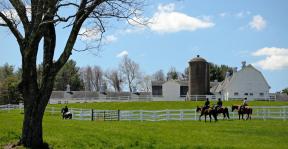Newtown unveils 13 proposed designs for Sandy Hook Memorial
Newtown unveils 13 proposed designs for Sandy Hook Memorial
Danbury News Times: Rob Ryser
Link to article HERE
NEWTOWN - As another American town reels from the savagery of a mass shooting, the families of the Sandy Hook massacre victims are deciding how to honor their 26 loved ones slain five years ago.
The families are reviewing 13 designs for a memorial that draw on themes of life, death and rebirth in nature.
The designs, which were selected out of 188 submissions from across the United States and 12 other countries, propose such features as reflecting ponds, walls of remembrance and trees that give color in winter to bring hope out of darkness.
“At the core of our design is the notion that the earth has the inexplicable ability to hold us and cradle our sorrows,” reads the narrative of one design. “It has the grounding strength and beauty which invites us to be supported by the land.”
Another design emphasizes the living nature of the memorial, which would be on five acres in the heart of Sandy Hook - close enough to the newly built Sandy Hook School to hear playground sounds on a still day.
“We wanted to acknowledge that the healing process does not end, but continues and grows - much like the incredible compassion which many victims’ families have put back into the world since the tragedy,” reads the description of one design.
That description referred to home-grown missions such as Sandy Hook Promise, a nonprofit co-founded by parents who lost first-graders in the 2012 massacre that has become one the leading violence prevention organizations in the country.
Leaders of Sandy Hook Promise were among the activists and family members who spoke out against gun violence and reached out in solidarity to grieving families in Parkland, Florida, last week, where a 19-year-old with an AR-15-style rifle was accused of murdering 17 students and adults at his former high school.
Kyle Lyddy, the chairman of the Sandy Hook Permanent Memorial Commission, said that while the group’s focus has been on a memorial that meets complex local needs, Newtown understands it is at the center of a national crisis.
Since 2013, there have been 290 school shootings, according to Everytown for Gun Safety.
“We totally understand that we are part of a larger conversation, and the amount of work that has been done by our families over the past five years to make this tragedy their life’s work is inspiring,” Lyddy said. “We want to continue to outreach to other communities and be a resource, because that was something that guided us.”
Lyddy explained that Newtown took lessons from Columbine High School in Colorado, the site of a school massacre in 1999, and from the Sept. 11 terrorist attacks on New York City in 2001.
Joe Daniels, the former president of the 9/11 Memorial, is among the advisers to the Sandy Hook memorial commission, which includes parents of children who died in 2012.
The 26 Sandy Hook families will be the first to comment on the 13 semifinalist designs. In early March, the memorial commission will ask for public input about the proposals, with the goal of narrowing them down to a handful of finalists by the end of April.
The designs will not include the names of architects who submitted them until a later stage. Designs may be viewed on the memorial commission’s web page at http://bit.ly/2F99bIK.
Nature’s inspiration
The semifinalist designs, which draw on the interconnectedness of nature as a central theme, are thorough and thoughtful proposals that impressed the commission with their creativity, Lyddy said.
For example, one design called for special plantings of fiery orange arctic sun dogwoods, which would be especially vibrant in December - the month of the tragedy.
“These designs would make sure that this memorial is something that lives in the winter months,” Lyddy said.
While some proposals are more technical in their descriptions of featured elements, others are downright poetic, invoking the existential and transcendental qualities of nature to give deeper meaning to woods, water and paths.
“Our path winds in gentle circles through a flowering woodland which celebrates the beautiful lives of the victims, eventually arriving at a central memorial clearing where the community can gather in love for those lost,” reads one design description. “The path has no true beginning or end, allowing visitors to experience the space at their own pace and in their own way, while always bringing them closer together.”
The appeal to nature is similar to the concept used in the design of the new Sandy Hook School, a $50 million building that replaced the one where the shooting occurred.
“We were really impressed by these submissions,” said Lyddy. “A couple of them just stopped us in our tracks and led to great discussions about how this can all come to life.”
A common strategy among the semifinalists was to marry the language of nature with the vocabulary of grief and healing.
“The design intent is to fill the irreplaceable loss of our children with a message of consolation, remembrance and hope,” reads one design description, explaining that its features symbolize “the nuanced emotional journey of confronting loss, feeling grief, and finding hope.”
The designs that stand out include those that name the memorial - such as “The Clearing” - and designs that give names to featured elements - such as “Path of Hope,” “Infinity Pond,” and the “Breathing Field.”
Other designs propose elaborate water features that use the twin ponds existing on the site or create new water elements. One design calls for a long, narrow “Water Mirror” with a “Community Circle” at one end and a “Waterfall and Weeping Wall” at the other.
Reflection, contemplation and healing are also major themes in the semifinalist designs.
One proposal, called “Forest Memories: A Landscape That Remembers” notes that because the memorial will be living, it will always be changing.
“The memorial will never have a moment of being finished, of ending,” the description reads. “It will never be the same, it will never happen twice.”
rryser@newstimes.com 203-731-3342



